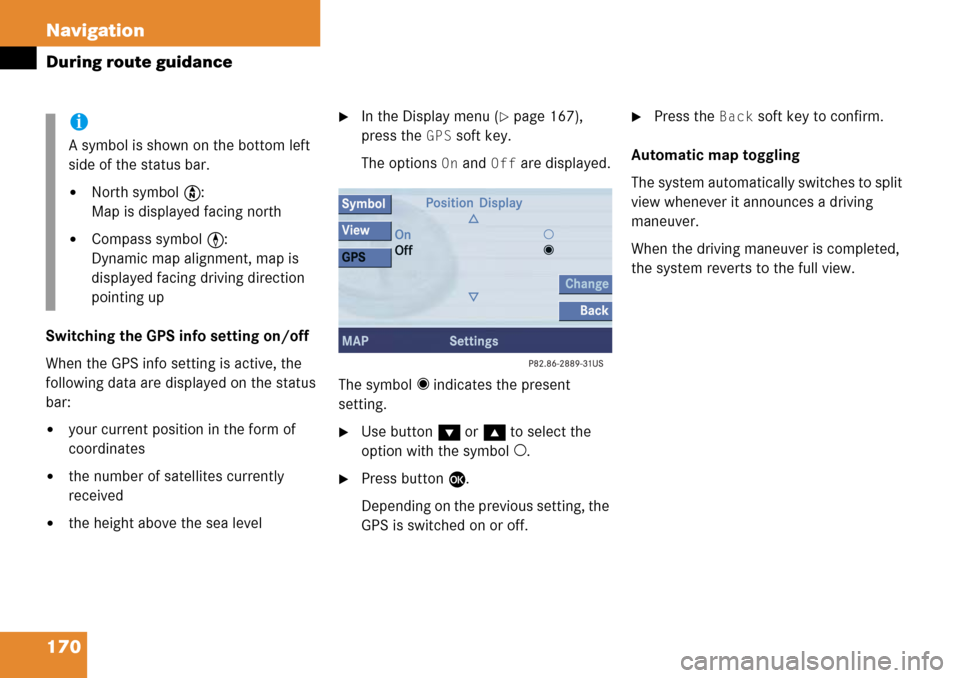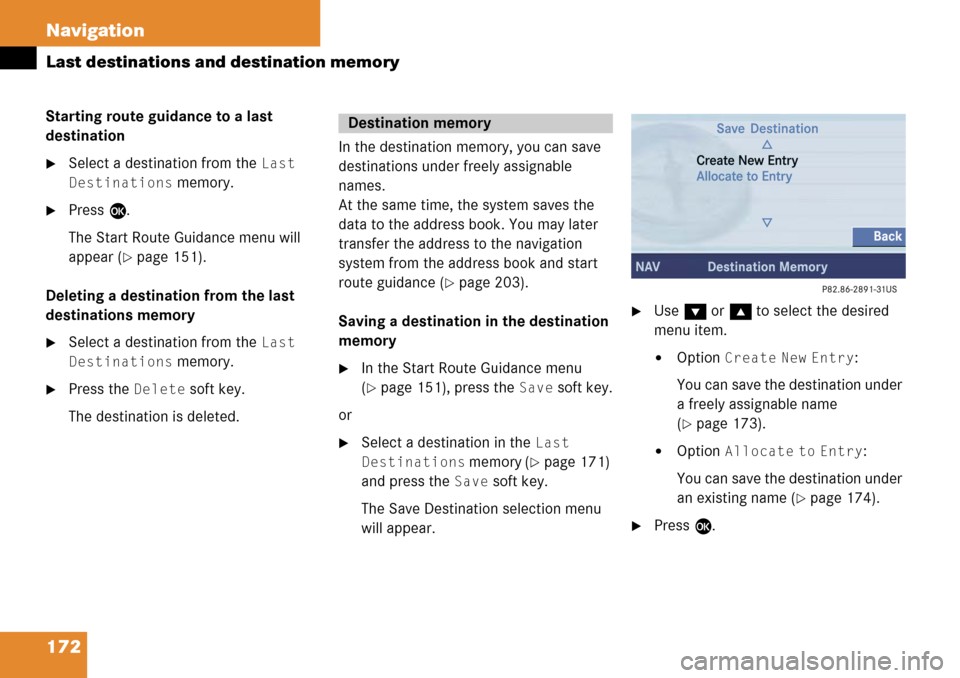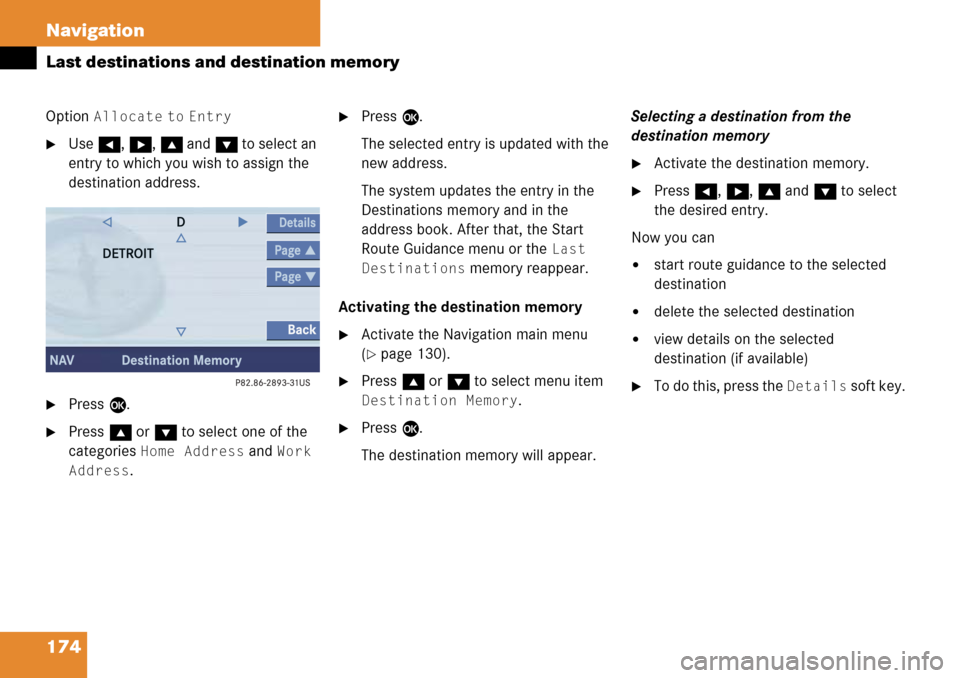Page 167 of 231

167
Navigation
During route guidance
�Use
g to select Delete Active
Stopover
.
�Press E.
The stopover destination last input is
deleted. The system calculates the
route to the main destination.
or
�Press G to select Replace Active
Stopover
.
�Press E.
The stopover destination is deleted and
you can enter a new stopover
destination (
�page 165). The system can save the current position
as a destination in the
Last
Destinations
memory (�page 171).
�Activate the soft key display
(
�page 160).
�Press the Memory soft key.
The current location is saved.
�Activate the soft key display
(
�page 160).
�Press the Display soft key.
The Display menu will appear.
You can now use the soft keys to
activate other menus.
�Symbol soft key:
Brings you to the symbol display
settings (
�page 168).
�View soft key:
Brings you to the map orientation
settings (
�page 169).
i
If no stopover destination has been
entered, the full view map appears
instead of the menu. You can now
enter a stopover destination
(
�page 165).
Saving the current location
i
Such destinations are marked in the
Last destinations memory with _
(
�page 171). Information such as date
and time or city and street supplement
the entry (if available). You can save up
to 20 such destinations.
If a destination is to be saved for later
or repeated use, the current location
can be stored in the standard
destination memory (
�page 172).
Defining route guidance displays
Page 168 of 231
168 Navigation
During route guidance
�GPS soft key:
Brings you to the
Position
Display
menu (�page 170).
Setting symbol displays
You can set which POIs are shown as
symbols on the map.
�In the Display menu, press the Symbol
soft key.
The available options are displayed.
�Press G or g to select an option.
�Press E.
The option is activated _.
�Default option:
The map shows the default
symbols.
�Personal option:
You can determine the symbols
which are displayed. The following
section explains the further
operation.
�None option:
No symbols are shown on the map.
i
You will see the symbols only if the map
scale is 0.05 mi/inch, 0.1 mi/inch, 0.2
mi/inch or 0.5 mi/inch (
�page 153).
Page 169 of 231
169
Navigation
During route guidance
Setting personal symbol display
�After selecting the Personal option,
press the
Change soft key.
The list of available personal symbols is
displayed.
�Press G or g to select a list entry.
�Press E.
The symbol is activated or deactivated
depending on its previous state. You
may also activate more than one
symbol.
�Press the Back soft key to confirm.
The settings are saved.
Setting map view
You can select the follwing map
orientations:
�2D North Up
Map is displayed facing north
�2D Heading Up
Dynamic map alignment, map is
displayed facing driving direction
pointing up
�Bird’s-Eye View
The map is shown in three dimensions
with sky and horizon.
�In the Display menu (�page 167),
press the
View soft key.
The available options are shown. Changing map view
�Press
G or g to select the
deactivated option.
�Press E.
The orientation is changed.
�Press the Back soft key to confirm.
MeaningSymbol
Selected Q
Unselected q
OptionSymbol
On_
Off -
Page 170 of 231

170 Navigation
During route guidance
Switching the GPS info setting on/off
When the GPS info setting is active, the
following data are displayed on the status
bar:
�your current position in the form of
coordinates
�the number of satellites currently
received
�the height above the sea level
�In the Display menu (�page 167),
press the
GPS soft key.
The options
On and Off are displayed.
The symbol _ indicates the present
setting.
�Use button G or g to select the
option with the symbol -.
�Press button E.
Depending on the previous setting, the
GPS is switched on or off.
�Press the Back soft key to confirm.
Automatic map toggling
The system automatically switches to split
view whenever it announces a driving
maneuver.
When the driving maneuver is completed,
the system reverts to the full view.i
A symbol is shown on the bottom left
side of the status bar.
�North symbol Y:
Map is displayed facing north
�Compass symbol <:
Dynamic map alignment, map is
displayed facing driving direction
pointing up
Page 171 of 231

171
Navigation
Last destinations and destination memory
� Last destinations and destination memory
The Last destinations memory
automatically saves last destinations to
which you have started route guidance.
The memory can save a maximum of 50
destinations.
You can save your current position as a
destination in the memory (
�page 134).
Such destinations are marked with _.
Activating the last destination memory
�Activate the Navigation main menu
(
�page 130).
�Press G to select menu item Last
Destinations.
�Press E.
The last destinations list is displayed.
The most recent destination is at the
top of the list. Selecting a destinat
ion from the last
destinations memory
�Activate the last destinations list.
�Press G or g to select an entry.
Use the
Page soft keys to scroll page-
wise through the list. Now you can
�start route guidance to the selected
entry (
�page 172)
�delete the selected entry (�page 172)
�save the selected entry in the
destination memory and at the same
time in the address book
�To do this, press the Save soft key.
Further operation is explained in
chapter “Save destination in the
destination memory” (
�page 172)
�view details on the selected entry (if
available)
�Press the Details soft key.
Last destinations memory
Page 172 of 231

172 Navigation
Last destinations and destination memory
Starting route guidance to a last
destination
�Select a destination from the Last
Destinations
memory.
�Press E.
The Start Route Gu idance menu will
appear (
�page 151).
Deleting a destination from the last
destinations memory
�Select a destination from the Last
Destinations
memory.
�Press the Delete soft key.
The destination is deleted. In the destination memory, you can save
destinations under freely assignable
names.
At the same time, the system saves the
data to the address book. You may later
transfer the address to the navigation
system from the address book and start
route guidance (
�page 203).
Saving a destination in the destination
memory
�In the Start Route Guidance menu
(
�page 151), press the Save soft key.
or
�Select a destination in the Last
Destinations
memory (�page 171)
and press the
Save soft key.
The Save Destination selection menu
will appear.
�Use G or g to select the desired
menu item.
�Option Create New Entry:
You can save the destination under
a freely assignable name
(
�page 173).
�Option Allocate to Entry:
You can save the destination under
an existing name (
�page 174).
�Press E.
Destination memory
Page 173 of 231
173
Navigation
Last destinations and destination memory
Option Create New Entry:
�Press
H, h , g , G , F or f to
select the characters. After each
selection, press E.
or
�Press one of the number keys 2 to
9 as often as needed.
�To delete the character last input,
press the
Delete soft key.
�Press h, H , g and G to select
symbol (.
�Press E. You can now select between the
categories
Home Address and Work
Address
.
�Press G or g to select the desired
category.
�Press E.
The system saves the address in the
selected category. After that, the Start
Route Guidance menu or the
Last
Destinations
memory reappear.
i
Do not confuse the Delete soft key
(deletion of the last character) with the
Back soft key (deletion of the complete
entry).
Page 174 of 231

174 Navigation
Last destinations and destination memory
Option Allocate to Entry
�Use H, h , g and G to select an
entry to which you wish to assign the
destination address.
�Press E.
�Press g or G to select one of the
categories
Home Address and Work
Address
.
�Press E.
The selected entry is updated with the
new address.
The system updates the entry in the
Destinations memory and in the
address book. After that, the Start
Route Guidance menu or the
Last
Destinations
memory reappear.
Activating the destination memory
�Activate the Navigation main menu
(
�page 130).
�Press g or G to select menu item
Destination Memory.
�Press E.
The destination memory will appear. Selecting a destination from the
destination memory
�Activate the destination memory.
�Press
H, h , g and G to select
the desired entry.
Now you can
�start route guidance to the selected
destination
�delete the selected destination
�view details on the selected
destination (if available)
�To do this, press the Details soft key.